Sixth edition: Outlines – defining things, places and people. Arco K: celebrating an icon, Guglielmo Poletti’s To-Tie, weaving light with Marcel Wanders Studio, 265 goes mini, around the world with Vincent Van Duysen’s Gustave, Ronan & Erwan Bouroullec design with light, two evolutions of Bellhop, Flos takes over Orobia.



Celebrating an icon
ARCO K
Achille & Pier Giacomo Castiglioni’s icon is celebrated with a limited edition of 2022 pieces, featuring a crystal base
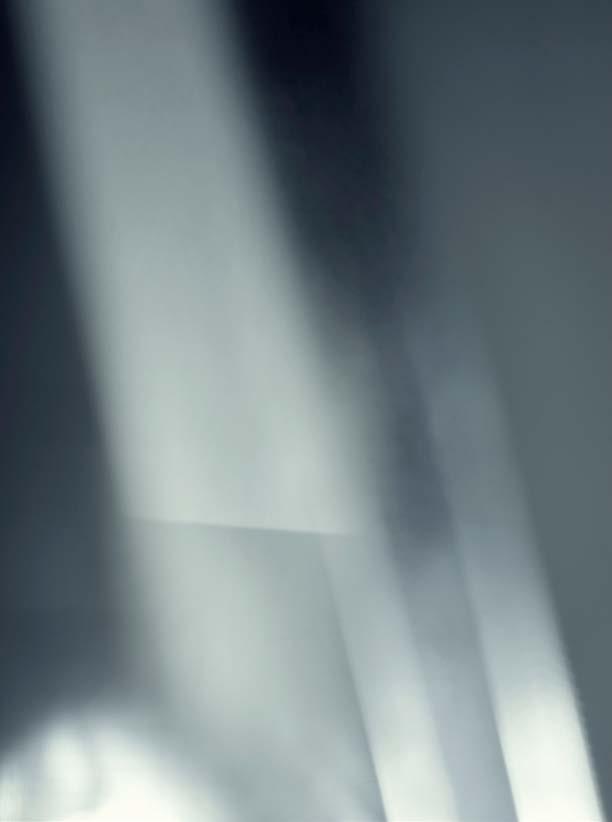 Photography by Mattia Balsamini and C41
Photography by Mattia Balsamini and C41
4
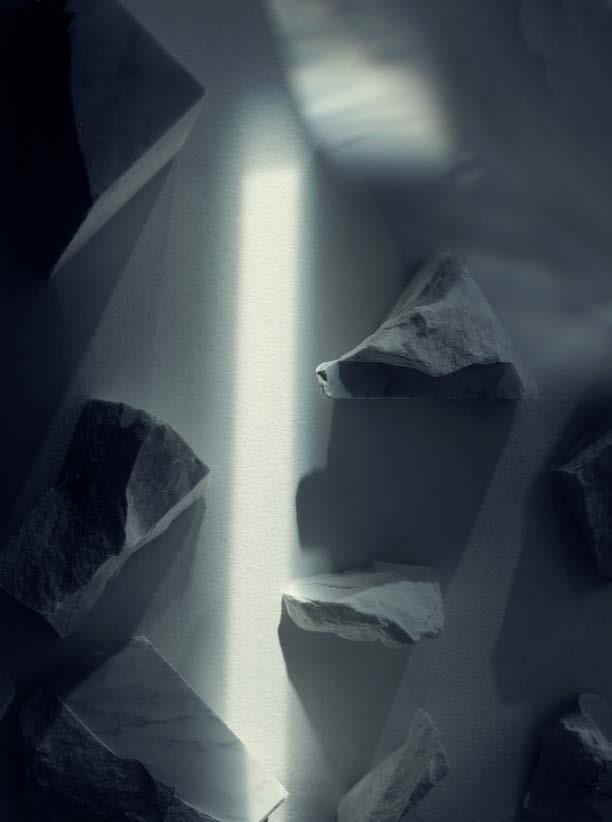
The ultimate design icon turns 60: a masterpiece of ingenuity conceived in 1962, the story of Arco follows the evolution of domestic interiors. Achille & Pier Giacomo Castiglioni invented a new typology of lamp as a response to modern living. ‘The design of Arco combines everything a good design product should have: carefully conceived functionality and a strong aesthetic that converge into an icon', says Fabio Calvi, Flos Design Curator with Paolo Brambilla.
The creation of Arco follows the trajectory of contemporary lighting design. Starting from the chandelier, with candles illuminating the centre of a room, the concept of lighting a space evolved into the single lightbulb, powered by electricity and hanging from the centre of the ceiling above a table. Inspired by streetlamps, the Castiglioni brothers freed the light from the centre of the ceiling, allowing it to move within a room. ‘They released the light source, responding to the necessity of creating a new furniture layout within a room, as a result of the evolution of contemporary interiors.’
In typical Castiglioni’s style, every functional aspect of the design was thoroughly considered with pragmatism and a touch of humour: the telescopic stem elegantly projects the domed shade (whose surface is punctured with holes to avoid trapping heat from the light bulb). This gesture is firmly held in place by a marble base, which was also conceived with essential functional details: chiselled corners to avoid breaking the material, and a single hole piercing through the marble. The idea was that by inserting a broomstick, two people could easily move it or rotate it to illuminate any area of a room.
‘Then Arco became an icon, a status symbol', continues Calvi.

‘Having Arco at home meant having made a modern choice, having chosen an object that was eccentric, that looked like the future.’

6
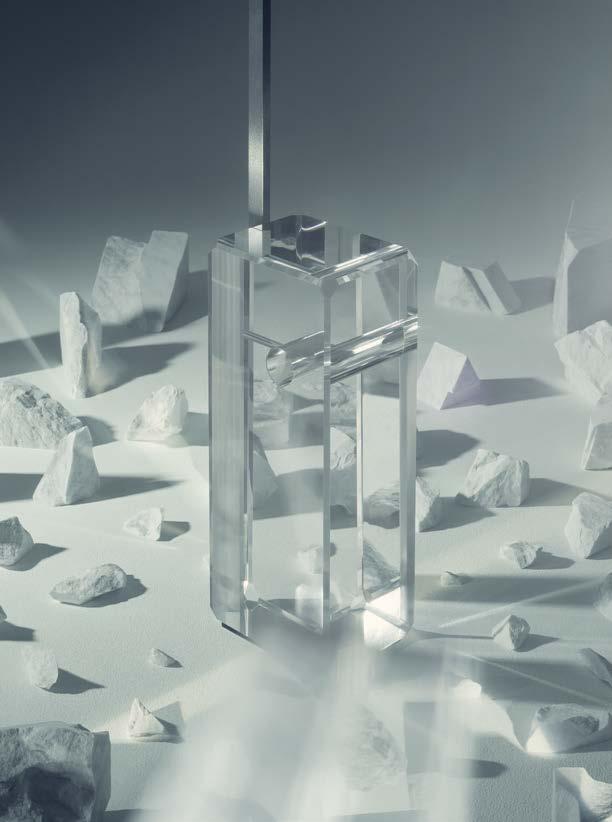

Fast forward to 2022, and now Arco is being celebrated by Flos with a limited edition of 2022 pieces that pay tribute to the Castiglioni’s design, bringing the silhouette of the lamp to the forefront. ‘Arco was the result of one of the happiest intuitions in the history of design and is universally acknowledged as an ambassador of Made in Italy in the world', says Brambilla. ‘The anniversary becomes an opportunity to rethink the lamp and enhance the design gesture of the Castiglioni brothers: the arch itself, the true essence of the project.’
For the celebratory edition, the base of the lamp disappears, replaced by the same form now crafted in crystal. ‘In 1962, when the lamp was conceived, marble was one of the most economical, durable and heavy materials available', explains Calvi. ‘But over the years, the iconic aspect of the marble has overshadowed some of the more important stylistic choices made by the designers.’ Over time, marble has become synonymous with luxury, something that wasn’t part of the Castiglioni’s idea for this design. By disappearing into the transparent material, the base allows the design of the lamp to come to the fore, their original design gesture to shine.

9
Brambilla adds: ‘The choice fell on a material that would not have been available 60 years ago: a specific lead-free crystal, which, thanks to its transparency, reveals the mechanics of the lamp.’ The chosen material is heavy, refined, technical and recyclable. Commonly used for optical prisms in labs and laser generators, to be manufactured at this scale Flos employed a specially-built machine that maintains the same high precision.
Arco K becomes a celebration of an iconic design and its history. ‘There is a whole story to tell from 1962 to date', comments Giovanna Castiglioni. ‘The great thing is that all these projects have interesting stories behind them, and there is a new version now that has made the captured of Arco’s movement. For this celebration, Arco becomes truly essential.’
Scan the QR code to find out more about the manufacturing.

10




ISSUE SIX: OUTLINES
During Fuorisalone, Flos took over the disused industrial spaces of Orobia 15: for several weeks, and for the first time, decorative, architectural, outdoor and bespoke collections were shown together under one roof, demonstrating the breadth and depth of their creative thinking and innovative approach to lighting at all levels - from portable to lighting installation. The exhibition showed Flos as a container of light and ideas, an outline of contemporary lighting. Photographer Piotr Niepsuj was invited to document the space and its guests: running wild across its rooms for 3 days, Piotr delivered a candid overview of Flos’ ability to be an aggregator (of designs, of people and the odd animal). His 35-page portfolio is a testament to Flos’ potential, and its impact on design.
Each lamp shown across these pages is the refined outline of an idea, a frame for light. Like Arco K, a tribute to Achille & Pier Giacomo Castiglioni’s ultimate design icon: its base is rendered in transparent, lead-free crystal so that the ingenious outline of its curved arm can shine. Or To-Tie, Guglielmo Poletti’s lighting debut, circling
light within glass. Meanwhile, the woven container of Skynest frames light with a language between craft and technology, and Barber & Osgerby’s Bellhop returns in a matte black edition, the result a smooth, discrete silhouette, and in bright colours, in the new Wall Up edition. 265 by Paolo Rizzatto, a mechanical gesture inspired by architecture, is joined by a smaller interpretation of its rigorously-conceived structure. More shapes of light also include Ronan & Erwan Bouroullec’s Luce Orizzontale, a composition of chunky glass tubes, and Belt, an essential line existing in the space (the latter was awarded with the Compasso d’Oro Award this year). Vincent Van Duysen’s Gustave (his portable light debut) seamlessly integrates aesthetics with technology in the most essential shape. ‘Flos have a creative madness that few have, and also incredible ingenuity, a very strong vision and values’, Gabriele Chiave, Creative Director of Marcel Wanders Studio told us. ‘In Orobia we saw the breadth and impact that Flos can have in the context of light, and what kind of partner it is for a designer.’
FLOS STORIES
Arco K A. & P.G. Castiglioni ↓

70 Paolo Rizzatto's 265 goes mini ↑
Games by Sany
80 Ronan & Erwan Bouroullec: Luce Orizzontale and Belt Fabric ↓



CONTENTS 152
154 Questionnaire Formafantasma 2
18 Tension
and To-Tie ↓
Master: Guglielmo Poletti




156 Contributors 157 New
Fall '22 40
Products
Woven Light: Skynest Marcel Wanders Studio ↓
58 Bellhop Matte Black E. Barber & J. Osgerby ↑
96 Bellhop Wall Up E. Barber & J. Osgerby
100 Gustave on tour ↑ Vincent Van Duysen
116
Orobia 15: a diary


TENSION MASTER: GUGLIELMO POLETTI AND TO-TIE
After graduating from Design Academy Eindhoven in 2016, Guglielmo Poletti started experimenting with creating furniture, using outlines and tension as design devices to create functional objects with a sculptural quality. This precise language is defined by curves, knots, intersections of paper-thin surfaces, something that you might call minimalism but which conceals a consideration for structure and construction that adds complexity to each piece.
His work unveils the essential, and the same can be said for To-Tie, a piece whose basic composition makes it the perfect lighting instrument. A glass cylinder supports an anodised aluminium rod concealing an LED source, the cable doubling as the structural element holding them together. To-Tie is a piece that speaks of Poletti’s ability to frame the empty space, the pinnacle of his design language but also the beginning of something new.
Photography by Bea De Giacomo
Interview by Rosa Bertoli
19


ROSA BERTOLI Let’s start from the top. Can you tell me about the beginning of your life in design and how you got into the path of becoming a designer?
GUGLIELMO POLETTI I didn't have a linear path and actually, I entered from the backdoor: I got interested in design in a self-taught manner. During my bachelor’s in art management, I attended a lecture by Philippe Daverio about design. It fascinated me deeply, and from that moment I saw design as a little flame, very far away. I tried to move towards it in an autonomous way, without any reference. I instinctively understood that I had to structure myself with some tools: In 2013, I did an internship at Lissoni studio and that was a very important experience, I learned a lot professionally but I was not sure it was my cup of tea, so that same summer I went to Boisbuchet for a workshop with Ron Gilad. He was a very important person for me, he showed me that you can approach design in a more independent and freer way, that your way of thinking can be a little bit disruptive and still it can reach the industry somehow. These two design personalities showed me very different ways of doing the same thing.
ROSA BERTOLI At this point, you hadn’t had any formal design education yet…
GUGLIELMO POLETTI Not yet. After some research, I thought that Design Academy Eindhoven would be the context where I could grow the most and understand what I was really interested in. It was a very analytical experience, over two years I went deeper into what it means to make design. I needed to have formal training, but at Eindhoven they don’t have any formula, it’s a very free way of teaching and they are very strict about how you create your attitude.
ROSA BERTOLI Was there a turning point for you in your work?
GUGLIELMO POLETTI The turning point for me was when I realised that I was more interested in construction and structure rather than arbitrary design choices. This helped me switch and therefore it informed everything I did from that point onwards, shaping the criteria that are still my guidelines today.
ROSA BERTOLI Mechanical tension is always part of your work. How did you arrive at this type of composition?
GUGLIELMO POLETTI I started working with these very abstract structural studies, I wasn't focusing on functionality. I realised these tensioning compositions had more formal qualities rather than functional. It was a mix of design, architecture and sculpture, I was wild and floating, which is a nice situation to be in when you’re still a student. But at the end of my second year, everything came together, I understood the functionality of my pieces as a deeper layer.
ROSA BERTOLI So it was quite gradual from experimenting with these compositions to you realising that they could be furniture?
GUGLIELMO POLETTI I arrived in Eindhoven with a very clear, “Italian” idea of what furniture design had to be. And it was nice to forget about it for two years, and think about design instead. And then in the end the essence of that little flame brought me back and I made furniture, which was the start of my career.
22
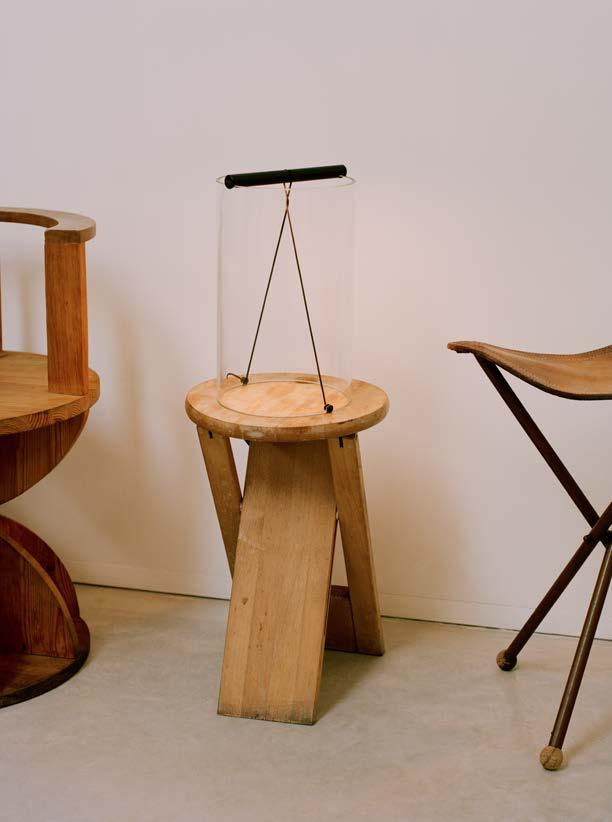






ROSA BERTOLI From your graduation work and the furniture pieces you created for Gallery Rossana Orlandi, you made a transition from experimental pieces to industrial design – now you’re bridging both worlds, how did you achieve this transition?
GUGLIELMO POLETTI The two years I spent in Eindhoven were a detour to get to the point of making functional furniture. Similarly, the limited -edition work I did was a detour to arrive to the industry with more defined criteria, and a stronger identity. So while it's true that the initial pieces I designed were more free and experimental, there was always a rigour in the way I was thinking about the works, and that allowed me to translate them for the industry. And even though some of my previous work has tried to push the boundaries of industrial furniture, it has also fit perfectly into industrial production.
ROSA BERTOLI To-Tie, your first collaboration with Flos, seems to fit perfectly into this progression.
GUGLIELMO POLETTI I think Calvi Brambilla decided to contact me as they had seen this progression in my work and they appreciated my criteria. When they first came to my studio, they were making very precise observations about my prototypes, it was clear they had got to the core of what I do. That made me trust that they would understand my process.
ROSA BERTOLI Did they give you a brief?
GUGLIELMO POLETTI They didn’t, which is exactly why I say they understand me. I think they realised that in my case a brief would have been extremely counterproductive. I am happy to have made this lamp because the final result is exactly how I originally visualised it. It’s important for me to have fun in my studio, have fun in the process. And they got that, so there was no brief, they were simply interested in what I do. After a month and a half, I presented several ideas, and among those was To-Tie.
ROSA BERTOLI Can you tell me about the process of designing To-Tie? How did you get to that essential shape?
GUGLIELMO POLETTI It was a big detour: the idea for To-Tie started from the Equilibrium table, from my graduation project, which I reworked completely into a suspension light, and in a couple of months, Flos had made a first prototype. That’s when my enthusiasm started to grow: I understood we could have fun together.
But that first prototype wasn’t working. It was then that Andrea Gregis, from the Research and Development Department, showed me a [1975] lamp by Castiglioni, Aoy, a table lamp made as a glass cylinder with a little hole underneath. I thought about that lamp and went back to the concept, and made a new prototype of To-Tie as a table lamp. I thought it was interesting to work on the idea of the joint, which was

27
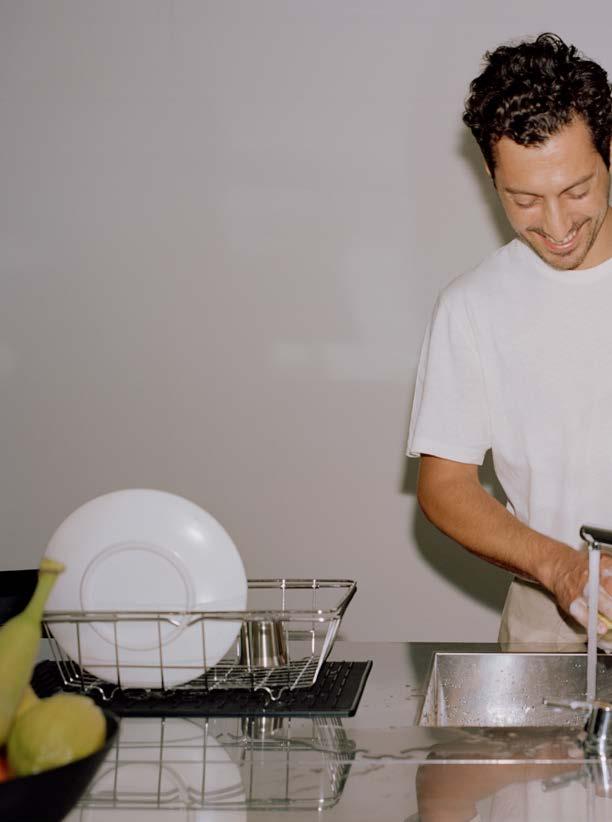

an integral part of the new prototype: a little acrylic cylinder with a very rough LED. I cut a metal tube and put everything together. When I turned on the lamp on my worktable, I thought, ok, this is really something now. I didn’t imagine it rationally: it was the process that did it for me.
ROSA BERTOLI How are the components arranged and put together to make this composition work? Did you discover anything through this process?
GUGLIELMO POLETTI To-Tie is much less arbitrary compared to other works of mine, which makes it more mature. The light is made like this because it has to be made like this, so that the cable provides first of all the structural element that keeps together the glass cylinder with the LED bar, just through mechanical tension, without any screws or joints, it's just a tensioning of the cable that keeps them together. And then the cable provides the electricity. One unexpected element I wouldn’t have realised if I hadn’t made the first prototype myself in the studio is the fact that the bar that is suspended in the middle of the cylinder can be used as a handle. So you can actually carry the lamp through the LED bar, which means that you don't have to touch the glass and leave fingerprints. Then the light comes from above into a glass cylinder, and this projection of the light is trapped inside the glass, creating the circle of light on the surface. And this is also unexpected: because glass is transparent, you think light will just escape, or be diffused all around. But instead it gets kind of trapped. So To-Tie isn’t just a nice-looking object, it also has an added value as a lighting design object. These are little things that make the work much more complete.
ROSA BERTOLI How did you work with the Flos team to develop To-Tie into its final form, starting from that first prototype?

GUGLIELMO POLETTI The Equilibrium table was already made of nothing, and to make the light we removed even more and then were left with just a few ingredients, but each of them performs a very precise function, everything has doubled functionality. The final object is naked: we spent one and a half years going from my little prototype that already presented some of the core of the idea, to the final work. It was about going deep into the millimetre, which is something that I love very much, it works well with my sometimes obsessive mindset. Sometimes in a process like this you feel limited, your interlocutor is not always following your rhythm. But with Flos, it was a game of ping pong and that was amazing. I was really touched to discover that we talked the same language, we all had fun going into the details.
ROSA BERTOLI Can you tell me about the materials and finishes of To-Tie?
GUGLIELMO POLETTI To-Tie was developed like a precious object: the edges of the borosilicate glass cylinder are finished by hand; the electrical cable is covered in fabric, and forms a knot that is both harmonious as well as functional; the cable retainers that secure it at the bottom of the cylinder were designed specifically for this project. Finally, the anodised aluminium bar is characterised by a discreetly knurled surface.

30




ROSA BERTOLI Was this your first experience with lighting design?
GUGLIELMO POLETTI I had played around with it a little bit, I did a project with Schloss Hollenegg in 2018, but that was more a structural object emitting light.
I understood quite early on that lighting is a serious matter. And it’s not that I don’t treat my furniture as a very serious matter, but with furniture, you can experiment and then get there, with lighting you can’t. You can make the hardware really beautiful, but what do you put inside? That part, the technological innovation, you cannot make up. Sometimes, limited edition lighting is a lot about the structure. When I was in Eindhoven I had a workshop with Nacho Carbonell, his lights are like incredible worlds. I remember he said, you can make a piece and the light is there in order to light the piece itself. But if you want to work with the light industry and provide good lighting for an architectural environment, you need a different approach. With Flos, it was the first time I worked with light in a technical way.
ROSA BERTOLI The name of the lamp itself is part of the design’s purity: it simply describes its function.
GUGLIELMO POLETTI It has to do with the fact that I am also trying to be more dry, because that's how you can deliver the core of what you think is interesting.
I'm not interested in conceptualising my work, I'm interested in the work being self-explanatory . The idea of calling the piece To-Tie brings you directly to what it is, a gesture around which the whole work develops. This gesture of tying is the key to the piece. And so, the name should complete the work: if you connect the name with the work then it becomes being self-explanatory.
ROSA BERTOLI How do you work when you're creating these prototypes in your workshop? What materials and tools do you use?
GUGLIELMO POLETTI My workshop is a micro version of Eindhoven, which was a huge workshop where you could work with any material, from wood to metal to plastics. In the workshop here I have everything that I need in order to put things together up to the point that it satisfies me to visualise an idea.
The prototype for To-Tie was roughly made here but that was enough for me to completely understand how it would work.
I have several materials, from wood and metal to cardboard and silicone - I am interested in setting up my workshop in a way that I can experiment, play with something I am not familiar with and get surprised. Often my work is like that: I have a little intuition about something and I make it. And nine times out of ten, that intuition doesn’t bring me where I thought it would. And that’s still interesting, and when you start learning to trust this process, you can never go back. Actually, if I don’t work this way, I know the process won’t work for me. There are no shortcuts, no being lazy.
This is the core reason why I am having fun doing this. It's also a bit scary because it's not about continuity, it's not the refinement of a predictable design language. Sometimes you're really looking for something, an unknown surprise.
ROSA BERTOLI You designed your studio space in Milan yourself, can you tell me about working on that project?
35

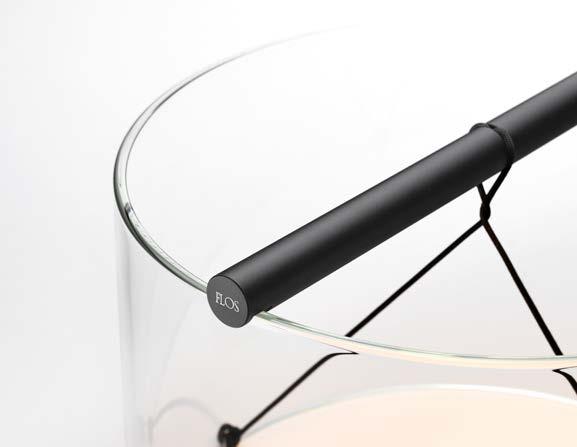
36
FUTURE PROOF
To-Tie is designed according to the principles of Circular Design. Its key parts are made of recyclable materials and they are held together by mechanical tension, without the use of any adhesives or welding. The lamp can be fully disassembled for repairs, replacements and correct recycling at the end of its lifetime. Replaceable LED source.


Learn more at flos.com/sustainability

ºº
GUGLIELMO POLETTI It was an industrial space that was very rough when I bought it, it had been used as storage by a construction company, and it was impossibly squeezed with materials. But it had potential, and I was planning to move back to Milan after 5 years in Eindhoven. This space was perfect: I wanted to have a workshop, I wasn’t interested in just a clean office, so I got it and renovated it. It was a slightly painful learning process, it was the first time I was doing architecture. I did a basic renovation of the space, I opened skylights to the top to get more natural light, and these skylights dictated the whole grid around which the office has been designed. The space is 3.75 metres high, so not enough to have two floors, but I wanted to use this height somehow. I was inspired by a trip to Korea, where they use this middle height structure a lot for storage and other functions. So I thought of making an elevated modular platform in birch plywood and glass with storage and a bedroom on the ground floor, and an office on the top. When you close the space, there is complete privacy, from the outside you don’t understand what it is about, but when you come closer you see that it opens up into the different elements, and on one side a staircase that breaks the symmetry. Working on small-scale architecture was an interesting challenge. I hope to find time and energy to grow and experiment in that direction in the future.

38

WOVEN LIGHT

Marcel Wanders Studio’s irreverent and poetic design language finds a new expression in Skynest, its latest lighting design for Flos. A combination of formal elegance and technical innovation, Skynest features an innovative LED strip, woven with a textile tube to create a basket-like form that is crafted yet sophisticated. Following on from the decorative approach of Skygarden (a 2007 design by the studio concealing a relief of flowers within a domed lamp), Skynest takes Marcel Wanders Studio in a new direction, enriching its humanistic, poetic approach with a new world of innovation, sustainability and technology. The studio’s Creative Director, Gabriele Chiave, talks about the dual nature of Skynest and the experience of designing with light.
PhotographybyAlessandroOliva InterviewbyRosaBertoli
40



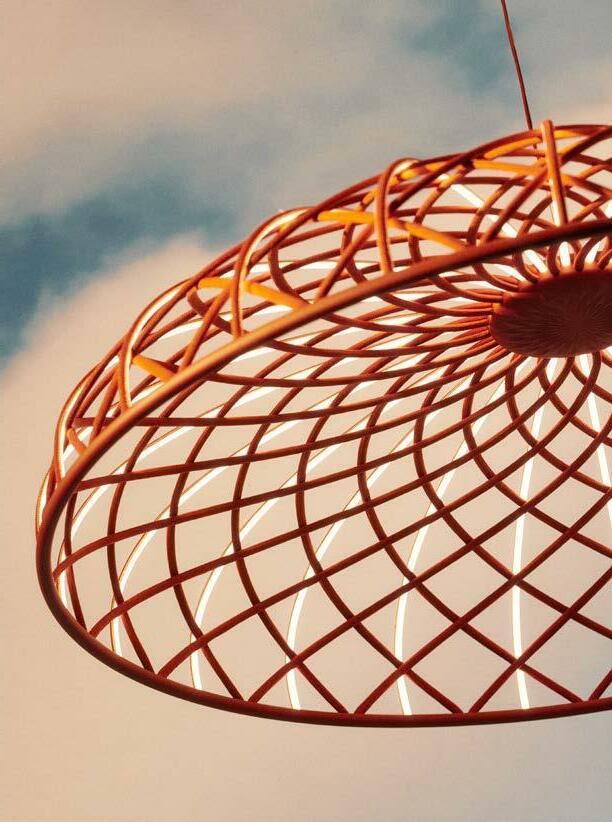

ROSA BERTOLI How did Skynest come about?
GABRIELE CHIAVE Skynest was born from a conversation with Flos about new light technologies: what elements, what new LED lighting sources can we explore, what’s new in terms of light?
Light is one of the fields of design with the fastest evolution, dematerialising more and more. The hardware used to be much more physical, while current technology allows us to have a light source that disappears, a light that is more magical and ethereal, less physical. Flos proposed this "spaghetti of light": a soft, flexible, luminous filament, roughly one metre long, which began the process that led us to Skynest.
ROSA BERTOLI How did you work around this “spaghetti”, and what inspired you in this creative process?
GABRIELE CHIAVE We thought about the filament itself: what do you usually do with a filament? Well, we make textiles, we weave it together.
Skynest is essentially woven light, an interpretation of craft processes: baskets, fishing nets. It all started from these first inspirations, and we started playing with these compositions.
ROSA BERTOLI It is a very technological lamp with a strong craft expression, it references ancient methods, but done with a modern material. What weaving techniques did you study, and how did you arrive at the final result?
GABRIELE CHIAVE Skynest was born from a language typical of baskets, but sophisticated to the point that it became a contemporary lamp. We wanted an object that was Flos, that wasn't too rustic. We made a historical as well as a geographical study of different methods of weaving materials: rigid wooden slats, wicker, textiles, hats, Japanese bamboo baskets – the latter were the starting point for weaving Skynest. The final result is a balance between artisanal weaving and a decoration that was a bit Marcel Wanders and a bit Flos, sophisticated and contemporary.
ROSA BERTOLI How did you develop the technical part, to get the maximum effect from the light source?
GABRIELE CHIAVE The filament originally emitted too much light, and when turned off it was yellow, it had the effect of overcooked spaghetti. So we developed sock-like containers made of recycled plastic. We inserted the filament of light in these two-tone socks (half pure white, the other half coloured), a process that enriched the technology. From there, we intertwined all the parts.
Skynest gives 360-degree light, the lamp casts no shadows, but only a perfect and highly calibrated light. The fabric shines with a refractive effect and gives a crazy strong depth. It is a very innovative light experience. The result is this woven fabric basket that magically lights up, and the origin of the light source is not obvious.
ROSA BERTOLI What are the strengths of Skynest?
GABRIELE CHIAVE The strength of the project is being able to combine the super-technological and innovative aspect with the more artisanal one. At first glance, it is a handcrafted object, with a humanistic touch. But it is also a super technological lamp, made of at least ten small inventions, which make it work as an object. The technology is hidden. It is also fully recyclable, each piece can be removed, each LED arm is attached with a USB connection and a small electro-welded connection that fits into the central aluminium disc. If you have to change a thread, you remove it, you replace it. And the lamp is very light, the weight of the materials is minimal, if you condense it all in your hand, it’s just a small ball of fabric and LEDs.
ROSA BERTOLI This is a point on which Flos is working more and more, hand in hand with the names of contemporary design, innovating within the language of design.
GABRIELE CHIAVE They have a rare creative madness, and incredible ingenuity, a very strong vision and values. In Orobia, we saw the breadth and impact that Flos can have in the context of light, and what kind of partner it can be for a designer.
46

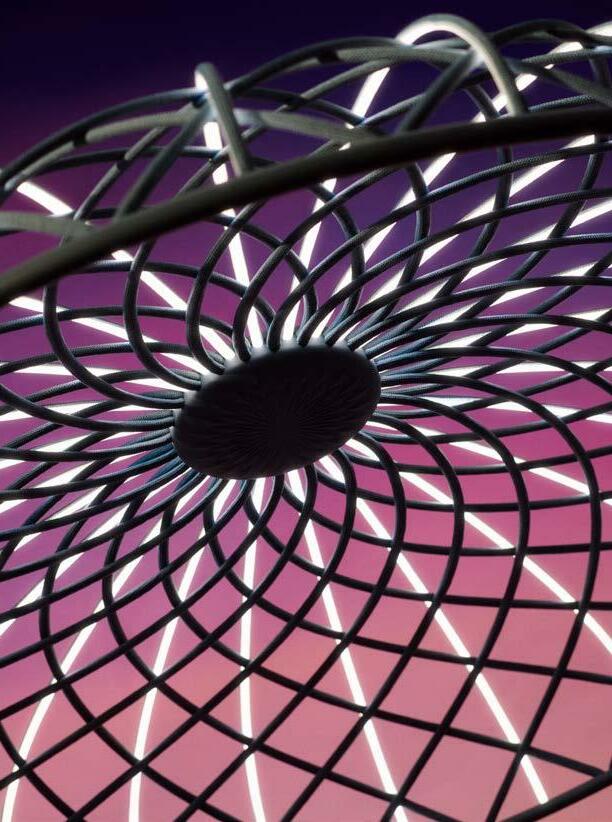




ROSA BERTOLI What role does technology play in design?
GABRIELE CHIAVE Technology is always in front of us, more and more, every day. The beauty of design, on the other hand, is that we like to hide technology. We use technology to become magicians, we hide it behind poetry of form, we create wonder. This is a theme that is increasingly present in architecture and interior design: light is like the brush on the canvas, like paint. In the case of Skynest, the fabric lights up and gives an incredible depth to the object. So it's poetic, but it's also industrial design. It is craftsmanship but also technology, it is elegant sustainability. It is many things combined.
ROSA BERTOLI How has the designer's work changed with respect to light, and light itself with respect to objects and experience in space?
GABRIELE CHIAVE The world of lighting has changed dramatically, and is still changing. In the last 20 years, the evolution has been continuous: from OLEDs to LEDs, to the diffusion of light, energy saving, and light quality technologies. Light is incredibly important: think of natural light, of the sun and the moon which determine the cycles of life, the origin of everything. Natural and artificial light are as one, with artificial light we try to replicate what we see in nature, so the design of light has evolved in this direction. Before, it was more about the object, it was more mechanical, there was a very basic structure that supported the light bulb, and so it has been for many years. The introduction of LEDs has led to a major revolution in industrial design and engineering. Beauty lies in making objects magical, using light in a poetic way, hiding technology by celebrating the object and the light. For a designer, this is a fantastic process: our work used to be much more sculptural, now it is largely driven by technology.
ROSA BERTOLI The lamp comes in different versions: can you explain to me how its presence in space was developed?
GABRIELE CHIAVE At the beginning of the project, I was holding a prototype, and it was very light: given its lightness, we thought of arranging this basket in var- ious ways. With just this one shape, we were able to create all the typologies typical of lighting design, and of Flos. So we made an Arco, with a curved tube, a Parentesi, which goes up and down on steel wires, turning 360 degrees, and then also wall and ceiling lights. Skynest has become a complete collection, both in terms of colour and typology.
ROSA BERTOLI In which direction is the studio's lighting work developing?
GABRIELE CHIAVE The designs of Marcel Wanders Studio have always been about poetry, our style is detached from the traditional Scandinavian and Modernist de- sign language: looking at Skygarden, this is evident. For Marcel, it is important to give people emotions that go beyond the pure function of the object; objects thus become carriers of memory and poetry.
The studio has evolved in that sense, and now we have arrived at Skynest, which represents the culmination of the last few years, as well as a great collaboration between our team and the Flos team. It is no longer just an artistic work, it is a team effort where everyone has managed to bring their experience to make the most of an idea of design, technology, craftsmanship and poetics. Skynest is also an expression of sustainability, quality of light, craftsmanship and collective memory: its richness lies in a series of elements that are very relevant in the current moment.
ROSA BERTOLI In which spaces do you imagine it, how do you hope to see it lived in an environment?
GABRIELE CHIAVE It was very nice to see it for the first time in Orobia, in all its versions, to demonstrate its versatility. The space around it was perfect: industrial, a little rough, white walls - ensuring that the lamps were at their best, and the space celebrated the project very well.
I’d like to see it in compositions, for example with eight elements on the wall of a hotel lobby, giving a very strong effect. And in very architectural spaces, where its personality can be expressed through light- ness and elegance: because it is a discreet lamp, it has a presence-non-presence. A delicate presence, made of transparency but which you cannot fail to notice.
53



FUTURE PROOF
The fabric used for Skynest comes from recycled Polyester and it is fully recyclable. Micro connectors allow for the replacement of each individual light source.
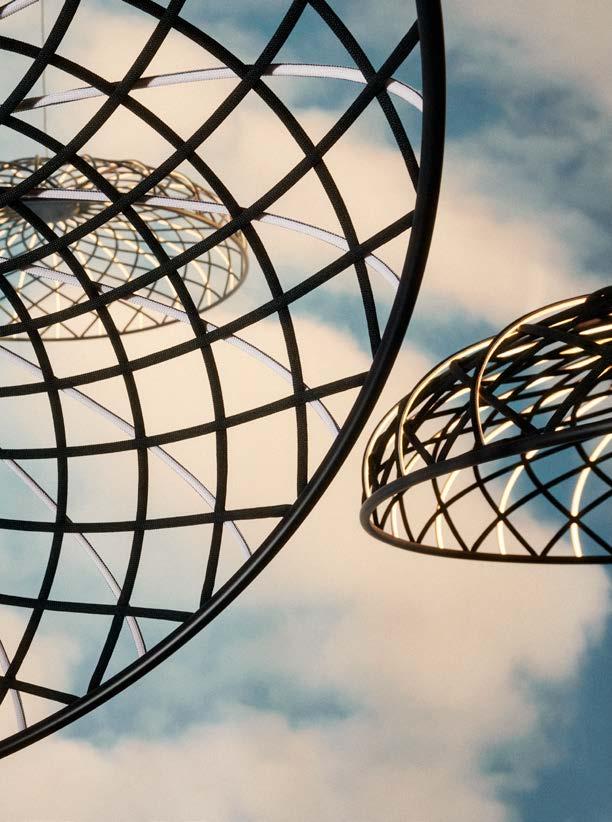
DESIGNED FOR SUSTAINABILITY
The lamp can be fully disassembled for repairs, replacements and correct recycling.
ºº
more at flos.com/sustainability
Learn
BELLHOP MATTE BLACK
Interviews by Eugenio Cirmi
 Photography by Ambra Crociani
Photography by Ambra Crociani
BELLHOP MATTE BLACK
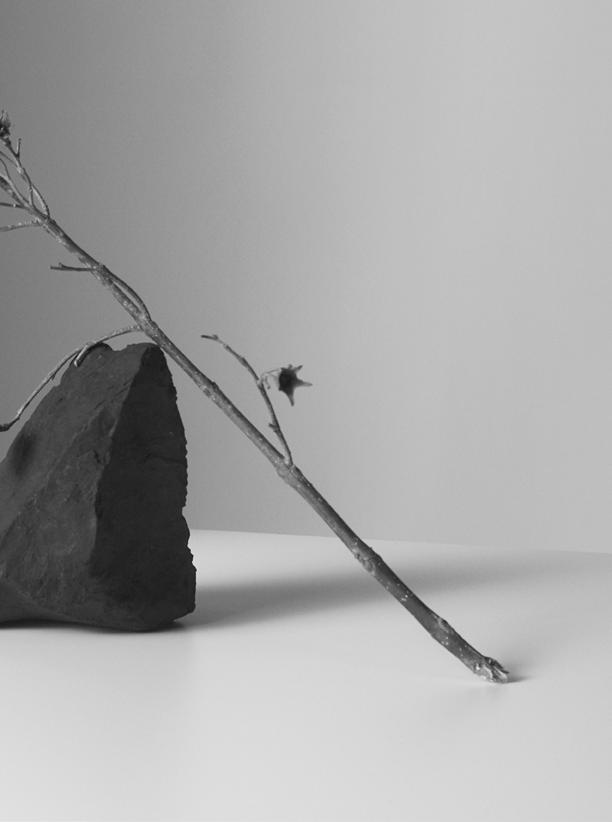 Designed by E. Barber & J. Osgerby
Designed by E. Barber & J. Osgerby

60
“Black makes me feel anchored. I love building a foundation of an idea I am feeling directly on paper with a black pen. That can be with words, or sketching, or an illustration. But it starts with black ink. Black makes my work feel tangible, real. And I rely on that as a starting point every morning.”


BEVERLY NGUYEN stylist

61

62


64
“I think of colors subconsciously when I create. Black can easily relate to sadness, but it can also evoke simplicity, luxury and elegance. It feels bold and powerful. To me, the color black can feel sophisticated and classic.”



65
SHEREEN MOHAMMAD artisan and model


67

68
“I’m trying to challenge myself to bring more color into my life; however, I’m creatively charged by black – I see it as a blank slate, it’s calming and intimate. Black is synonymous with being classic. Take the “Little Black Dress,” for example. Something so timeless because of the color is deemed the most versatile and sustainable thing a person can have in their closet. It’s timeless.”
JESSI FREDERICK artist and photographer



69
An illustrated comic series
by Andreas Samuelsson
265 goes mini
Designed by Paolo Rizzatto
70
Same ingenious design, smaller size.
Paolo Rizzatto’s 265 returns in a diminutive version, a companion to the original that maintains its precise proportions with a more compact form. In 1973, Rizzatto applied his architect thinking to lighting. Intuitive, technical and precise, the result is as simple as it gets: a suspended wall lamp essentially made of a head and weight, each balanced at the extremities of an adjustable arm, and attached to the wall in an asymmetric position. To enhance its composition, Rizzatto had originally drawn it in primary colours (each identifying one of the design’s three elements: head, arm and weight). His democratic design (available in black, white and Chromatica) is now even more versatile thanks to the reduced proportions.
71
Now available
in a smaller size

Ronan & Erwan BOUROULLEC: LUCE ORIZZONTALE and
BELT FABRIC
Photography by Federico Torra Set design by Elena Mora



Luce Orizzontale by Ronan & Erwan Bouroullec is a sculptural lamp combining exquisite craftsmanship and cutting-edge manufacturing technology.
Originating from an ambitious Flos Bespoke project, the design of Luce Orizzontale distils the concept’s artisanal complexity: an interlocking, modular structure composed of tubular elements of thick glass, minimally suspended from the ceiling.
The lamp’s modular configuration includes 8, 10 or 12 cast glass tubes (its size ranging from one and a half metres to two and a half metres), and hanging structures of different lengths. The glass cylinders are supported by a polished aluminium bar, while the light sources, two LED strips pushing the light upwards and downwards, are inserted in the bar, and can be dimmed through a system located at one end of the bar.
It’s a poetic yet technical sculpture, a functional lighting object that conveys the Bouroullec’s ability to simplify through design, embracing technical complexity and transforming craft into its most modern expression.
‘It is not a technical glass', explain Ronan & Erwan Bouroullec, ‘but an ever-changing material, almost alive, with aluminium extrusions inserted through it. The result we wanted to achieve was precise, but also fluctuating and vibrant.’
GLASS MARVEL



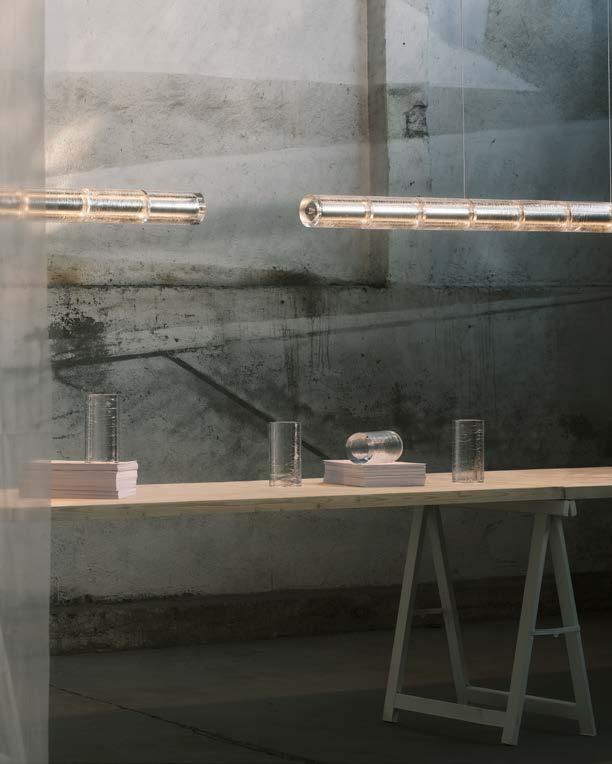


Ronan & Erwan Bouroullec’s ingenious Belt lighting system for Flos Architectural wins the Compasso d’Oro 2022.
In their lighting works, Ronan & Erwan Bouroullec like to chase the unexpected. This is especially true of Belt, a 2020 lighting design featuring a leather harness (inspired by horse riding) concealing the lamp’s power cable, making a sinuous segue into rigid LED beams. Organic forms merge with straight lines, creating a dancing of shapes falling from the ceiling, rotating, growing in multiple directions and moving freely in the space. A belt that grows, moves, plays with the architecture, offering a sense of enchantment typical of the Bouroullec’s work.
Originally available in artisan-crafted leather in black, green and natural finishes, in 2022 Belt developed into a new fabric version, comprising a recyclable textile in olive green and copper brown.
The intelligent harmony of Belt was awarded with the 2022 Compasso d’Oro ADI, one of the highest accolades in design, now in its 27th edition. The 10th Compasso d’Oro awarded to a Flos product, it was selected by an international jury that was captured by Belt’s environmental sensibility and originality of thought, bridging technical and decorative lighting and embodying Flos’ philosophy of innovation, craftsmanship and design.

STRIKE GOLD: BELT WINS THE COMPASSO D’ORO AWARD


 Introduced in 2022, Belt Fabric features a durable and recyclable stretch textile available in grey olive and copper brown.
Introduced in 2022, Belt Fabric features a durable and recyclable stretch textile available in grey olive and copper brown.
BELLHOP WALL





96
BELLHOP WALL UP



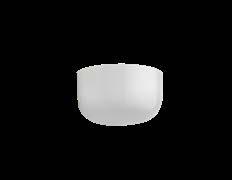

97
Designed by E. Barber & J. Osgerby

Since launching Bellhop Table in 2017, the design by Barber & Osgerby has evolved into a family of objects that branch out into different areas and lighting functions. From a compact rechargeable lamp, Bellhop has become a floor-standing uplighter and an outdoor light. Now in its latest iteration, Bellhop is integrated into the architecture, colourfully perching on the wall and pushing light upwards thanks to Flos’ new, high performance optic technology. The new design maintains the lamp’s distinctive shape, with the cap twisted upside down and declined in a series of rich hues that well complement its bold design.

99
Photography by Francesco Caredda and Sara Fileti

GUSTAVE ON TOUR
To celebrate Vincent Van Duysen’s first portable light for Flos, we took it on a trip to three restaurants: Rosetta in Mexico City, Lode & Stijn in Berlin, and Saga in New York, testing its design possibilities and adaptable nature in a series of diverse settings. At each location, the lamp’s soft glow charmingly graces the tables, contributing to the atmosphere.
Gustave was imagined as a perfect dining companion. Compact, elegant and adaptable, Van Duysen’s portable light adapts to different interiors and moods. Versatile, distinctive and minimal, this lamp was inspired by Adolf Loos’s iconic table lamps, and named after Monsieur Gustave H., the legendary concierge of Wes Anderson’s aesthetic masterpiece Grand Budapest Hotel.
Its soft, compact forms conceal a combination of LEDs and patented lens, whose unique positioning results in a bright beam, falling obliquely on the surface underneath and stretching around the stem with an even, 360° illuminating effect.
ROSETTA Mexico City
Owner Elena Reygadas describes Rosetta as ‘a living organism’: located in a large mansion in Mexico City’s Roma neighbourhood, the restaurant’s menu is based on seasonality and availability of fresh ingredients.
The restaurant’s set up is composed of different rooms, each space featuring a unique character. ‘I have always thought that there are two Rosettas: one during the day and one during the night. Both have something very special’, observes Reygadas.
Guests dine within a tropical atmosphere by day, surrounded by plants and natural light. At night, subdued illumination contributes to a mysterious, intimate atmosphere. ‘What matters the most is the experience inside the restaurant’, says Reygadas.
‘After the Covid-19 pandemic, I decided to transform the third floor of Rosetta into a bar called Salon Rosetta’, continues Reygadas. ‘One of the most important challenges was the lighting. It is a small bar, which I hoped would become a place where everyone would feel comfortable and relaxed.’ Paola José, director of lighting design studio Sombra, created some specially-designed lamps for this space, to bring to life the old Chinese panels covering the walls. ‘These pieces’, continue Reygadas, ‘allow the bucolic scenes of the panels to manifest themselves in the bar as ghostly presences’.
‘In my restaurant, I seek to use a type of lighting that generates pleasant atmospheres and invites customers to enjoy the space. I am not so much interested in having them take great pictures, but rather that they have a fulfilling experience’.
Photography by Pia Riverola





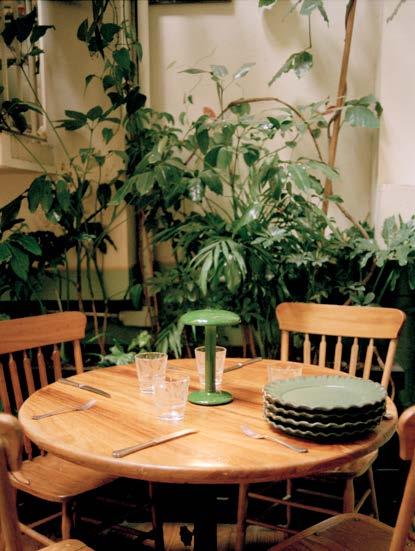

SAGA NEW YORK
‘Eating at Saga is meant to feel like you’re dining in the home of a fancy friend’, says executive chef and partner James Kent. Set on the top four floors of an Art Deco building in New York (a space originally conceived as a bachelor pad), its intimate interiors boast uninterrupted views of the city and were designed with light in mind.
Light is a big deal at Saga: ‘I’m never more acutely aware of light than I am when I’m sitting in the dining room’, continues Kent, who likes to spend as much time as possible in the space, from meetings through service, to observe how it changes throughout the day. ‘I see the shadows move across the carpet in the late afternoon then watch the sun set over the skyline and the lights in Manhattan skyscrapers cascade on.’
Guest arrive at night, for dinner service (Saga doesn’t serve lunch): in the summer, it’s still daylight, and as light shifts, the space gets more dramatic. Kent explains that the designers of the space, architectural firm MN DPC, tweaked their design to ensure it would glow at golden hour. At night, the space is meant to feel like it’s lit by candlelight: ‘ A lot of our work is meant to make the dining experience feel more intimate. There’s little that’s more effective in creating a sense of intimacy than light: lighting in a restaurant is all about creating a mood, so I tend toward warmer options. As long as diners can see what’s on the plate, I’m satisfied.’
Photography by Brian W. Ferry



LODE & STIJN BERLIN
Lode van Zuylen and Stijn Remi run this small Berlin restaurant focusing on a seasonal cuisine using ingredients sourced as directly as possible, delivered in a relaxed atmosphere.
Upon opening the restaurant, the pair admits that lighting wasn’t on top of their agenda. ‘We didn't really think deeply about a perfect light plan’, admits van Zuylen. Luckily, their friends at Dutch multidisciplinary design studio La Bolleur took care of the design of the space, which includes Achille Castiglioni’s Frisbi for Flos. ‘These lights aren’t just really beautiful objects, but the light that gets reflected is really great for a table setting as it is not a spotlight. It helps connect people sitting at the table.’
The restaurant’s interiors are warm and minimal: wooden floors, mid-century inspired furniture, geometric artworks and large windows overlooking the street, offering natural sunlight throughout the morning. ‘Still, the transition from day to night, especially between April and October, is a beautiful thing to witness’, adds van Zuylen. ‘It sets a kind of tone that is hard to describe, even more so when the sun shines a dark orange colour that gets reflected on the building across the street into our dining room’.
When quizzed about the perfect light to serve foot, van Zuylen enthuses: ‘Actually, the lights we have are perfect: it feels like the table is within its own sphere because of the shape of the light’.
Photography by Volker Conradus


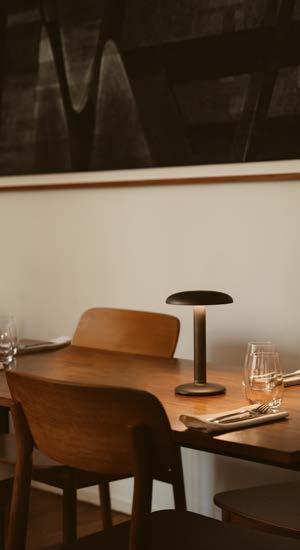


Designed by Vincent Van Duysen GUSTAVE


BROAD LIGHT COVERAGE
Patented lenses engineered to maximize lighting up to 1 meter while ensuring amazing visual comfort with its asymmetric 360 º light beam.



CABLE OPTION
USB - C option for charging through electricity.
BATTERY-OPERATED OPTION
To replace during the service without interruptions.
SUSTAINABLE DESIGN
The lamp has been designed to be future proof. All parts can be easily replaced in case of need. No screws or glues allow for an easy disassembly of the lamp for the replacement of individual components or to dispose of them correctly.




Learn more at flos.com/sustainability
USB-C POWERED USB - C for charging through electricity.
CAPACITIVE TOUCH BUTTON
To easily turn on and off the lamp and dim the light.
SUITABLE FOR OUTDOOR USE
IP54 certified.
60 YEARS!
Orobia 15 —a diary from Flos’ anniversary event at Milan Design Week 2022 as seen and told by Piotr Niepsuj
Let’s put things straight from the beginning — I’m a photographer and I don’t know much about the design world, but for some reason renowned company Flos asked me to document their 60th anniversary, which they celebrated this year during Milan Design Week. The following pages are the diary of what I heard and saw and who I met in Orobia 15 a post-industrial complex of 6000 square metres in south Milan which Flos fully transformed into a multi-functional hub to host talks, workshops, music, books, drinks, food and, of course, lamps! Lots of lamps.
Among flowers, Roberta Silva, CEO of Flos, during her opening speech.
116



OK. To be completely honest, even though I’m not a design aficionado, I do know Flos lamps. As a Milanese local (I wasn’t actually born here, but I’ve lived here long enough to claim this title), I’ve seen them so many times in the homes of my friends that I figured out these lamps are... relevant (actually, I’ve seen them so many times that I even knew the names of some of them).
When Flos approached me about this diary, I was a little wary and stressed on one hand (would knowing Arco, Parentesi and Toio be enough?) but excited and curious on the other. I usually flee Milan during Design Week as the crowds are a little too overwhelming for me (apparently 600,000 people flooded into the city for it this year) but hey, how could I miss such a big opportunity? And so it was that I decided to stay for the first 3 days before everybody had arrived and although I missed the talks, workshops and the party that happened after, at least I had chance to see everything without too much distraction and to talk to a lot of (nice!) people and to understand what Flos is really about (spoiler: it’s about tradition, innovation, sustainability and hard work) and what it takes to organize such an enormous event (spoiler: a lot of time, people and hard work).
Hopefully nobody will be offended.
119

The whole event was called ‘See the Stars again’ (#seethestarsagain) and I guess that referred to the lamps, because there were so many that they really did seem like stars in a summer sky. Also, Flos —how can I get my hands on this outfit?
Arco —the biggest star of this event (pictured here with Giovanna Castiglioni) The Flos staff referred to it as ‘our baby’. I thought it was weird to call a 60-year-old lamp a baby but hey, it’s a family thing!

121


Just when everything was about to begin… it started to rain

123

Konstantin Grcic wearing his iconic Mayday lamp as a hat. After 20 years, the outdoor version of Mayday is now also available and, as tested by the design week rain, I can confirm it’s fully waterproof.


125

126
Felix Burrichter of PIN - UP magazine hosting (flosting?) the event.


127
Guglielmo Poletti stretching next to his To-Tie Lamp (my personal favourite).
Formafantasma and Terra arriving at the party.

128


Marcel Wanders and Gabriele Chiave searching for UFOs (actually pictured with Skynest, the new lamp designed by the studio).

Man behind the design (Michael Anastassiades).


133
Man inside the design (Guglielmo Poletti).
Side note: If I was a designer, this would be “my idea” of the lamp (on the right) and “reference” (on the left). Fortunately I’m not a designer!


134
Fortunately Patricia Urquiola is a designer! Patricia Urquiola under her Almendra lamp, almost like sitting under an almond tree.

135

136
Erwan Bouroullec searching for his brother Ronan.
Jay Osgerby imagining posing with Edward
who was stuck in traffic (or pretending to be Arco?)
 Barber,
Barber,

Unofficial merch. 138

Official merch. 139
A highly exclusive shot of Arco as a straight line.

140
A highly exclusive shot of Erwan Bouroullec changing the led bulb in Luce Orizzontale, designed by him and his brother Ronan.

141

Crowds (on opposite page) in front of stadium (on this page) illuminated by Vincent Van Duysen’s Oblique lamps.

143
A REAL bird! For some reason somebody invited a family of ducks to the event.
My favourite part of the exhibition — lights designed not to scare animals. Very happy to discover that Flos is thinking about the whole planet.

144


Design loves colours too.

147

148
Magic by Sayaka Sawaguchi from the gastronomic collective We Are Ona.


And last but not least — the only lamp in 6,000 square metres that wasn’t designed by Flos. Helloooo, did I just find a gap in the market?

151
Which To-Tie reaches the goals fastest? Consider speed, time and velocity.

To-Tie by Guglielmo Poletti
GAMES
Connect the dots and draw a Skynest.
 Illustrations by Sany
Illustrations by Sany
Some Light Entertainment
Skynest by Marcel Wander Studio
152
route does the climber need to take to spell


Which
the Bellhop Wall Up? Bellhop Wall Up by Barber & Osgerby Help Arco K to find the right hat.
Castiglioni 153
Arco K by Achille and Pier Giacomo
Formafantasma
Andrea Trimarchi and Simone Farresin of Formafantasma apply their research-based approach to every aspect of design, questioning its role through the lenses of ecology, history, politics and culture. Their work balances a well-considered, pared-back aesthetic with a constant attention to every aspect of the design practice – case in point their WIRELINE suspended lamp for Flos, where the power cable becomes a design gesture. We ask Andrea and Simone about how they live, and what they love. Picture by Olya Oleinic.

QUESTIONNAIRE
154
What’s most precious to you?

How do you work together?
The last book you read.


What are your star signs?
What do you do to relax?
If you weren’t humans, what would you be?
How do you start your day. Draw your favourite tool.

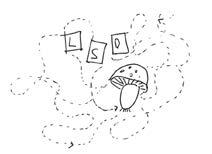



Where would you like to live?
Tell us something you’ve never done.
155
Contributors
Mattia Balsamini photographed Arco K, a tribute to Achille & Pier Giacomo Castiglioni’s game-changing lamp, on the 60th anniversary of its creation (cover)
Eugenio Cirmi interviewed three New York-based creatives, quizzing them on the colour black and why it’s important in their lives and work, on the occasion of Barber & Osgerby’s Bellhop being released in matte black (p.58)
Berlin based photographer Volker Conradus immortalised Vincent Van Duysen’s Gustave portable lighting in the city’s Lode & Stijn restaurant (p.100)
For Flos Stories #6, Milanese photographer Ambra Crociani shot a portfolio inspired by the new Bellhop Matte Black, mixing New York based creatives, nature and inanimate objects (p.58)
Stilema Studio worked alongside Ambra Crociani to create an evocative narrative that brings the new Bellhop Matte Black to life (p.58)
Bea De Giacomo visited designer Guglielmo Poletti at his studio in Milan, following him through his everyday activities and discovering To-Tie, his lighting debut for Flos (p.18)
Brian W. Ferry is a photographer based in New York. He took to local restaurant Saga, where he photographed Gustave in the sophisticated setting (p.100)
Set designer Elena Mora created essential compositions to frame Luce Orizzontale and Belt Fabric by Ronan & Erwan Bouroullec (p.80)
This past June, Milan-based photographer Piotr Niepsuj was thrown into design’s deep end: documenting Flos’ Orobia installation during Fuorisalone offered a unique, charming point of view of the event and its participants (p.116)
Technology and craft merge in Marcel Wanders Studio’s Skynest, cleverly photographed by Alessandro Oliva to highlight the lamp’s simple yet intricate design (p.40)
Barcelona-born, Mexico City-based photographer Pia Riverola , went to Rosetta, where she caught the Gustave portable lamp in the restaurant’s charming setting (p.100)
Swedish illustrator Andreas Samuelsson was tasked with telling the story of the new 265, a design classic now available in a smaller size (p.70)
Illustrator and artist Sany, aka Samuel Nyholm is based in Stockholm. For this issue, we asked him to come up with some fun and games featuring To-Tie, Skynest, Bellhop Wall Up and Arco K (p.152)
Interiors and architecture photographer Federico Torra’s images highlight the formal simplicity of Ronan & Erwan Bouroullec’s Luce Orizzontale and Compasso d’Oro-winner Belt Fabric (p.80)
Concept and Creative Direction
Apartamento Studios
Managing Editor
Rosa Bertoli
Graphic Design
Apartamento Studios
Flos Team
Barbara Corti
Rosaria Bernardi
Elisa Bodei
Silvia Delaini
Donatella Matteoni
Francesco Funari
Diletta Dincao
Translations
Team Agiliz@ tu gestion
Acknowledgements
Pablo Amati
Ronan & Erwan Bouroullec
Paolo Brambilla
Fabio Calvi
Ángel Cánovas Celdrán
Gabriele Chiave
Jessi Frederic
James Kent
Serena Matarrese
Shereen Mohammad
Beverly Nguyen
Guglielmo Poletti
Olya Oleinic
Elena Reygadas
Paolo Rizzatto
Vincent Van Duysen
Lode van Zuylen and Stijn Remi
Printing
Graficart, Treviso
September 2022
156
NEW PRODUCTS
DECORATIVE COLLECTION Arco K A. & P. Castiglioni 1962 pag 158 265 Small Paolo Rizzatto 2022 pag 158 Skynest Marcel Wanders 2022 pag 159 Luce Orizzontale .................... R. & E. Bouroullec ................... 2022 ............................. pag .......... 159 Bellhop Wall Up .................... E. Barber & J. Osgerby ............ 2022 ............................. pag .......... 160 Bellhop Matte Black ................ E. Barber & J. Osgerby ............ 2022 ............................. pag .......... 160 To-Tie .................................... Guglielmo Poletti .................... 2022 ............................. pag .......... 161 ARCHITECTURAL COLLECTION Gustave ................................. Vincent Van Duysen ................ 2022 ............................. pag .......... 162 Belt Fabric R. & E. Bouroullec 2022 pag 162 157
Fall '22
Arco K
A. & P. Castiglioni, 1962

Materials: crystal, aluminium
Power: MAX 100W
Voltage: 120V
Light Source: A-21 Medium Silvered Bulb Incandescent
265 Small Paolo Rizzatto, 2022
Material: steel
Power: MAX 75W
Voltage: 220-250V

Light Source excluded: LED 11,5W E27 1100lm

Available in: black, white, chromatica

95'' 21.5'' 56’’/62’’/68’’ 59.05'' 22.44'' Ø 11.5’’ 9.4''
9.45'' Decorative CollectionNew Products Fall '22
74.6’’/76.6’’/78.6’’
FU030400
2400 mm 550 mm 1510/1850 mm 1500mm 570 mm ø 320 mm 240 mm 2200/2150 mm 240 mm
AU032009 AU032030 AU032099
158
Skynest S
Marcel Wanders, 2022

Materials: nylon with glass fibre, recycled polyester, LATAMID, lacquered aluminium


Power: 78W
Voltage: 100-240V
Light Source: LED 78W 6650lm 3500K CRI90

Available in: anthracite, blue tomaline, almond, brick red
Luce Orizzontale Ronan & Erwan Bouroullec, 2022
Materials: glass, aluminium, steel, polycarbonate, PMMA



Power: S1 100W / S2 145W / S3 165W
Voltage: 100-240V
8.38'' ø 36.38'' 65.19'' 97.95'' 81.57'' ø 4.05'' ø 4.05'' ø 4.05'' Decorative CollectionNew Products Fall '22
F6392031
F6392003
F6392017
F6392035
S1 LED 100W 4500lm / S2 LED 145W 5750lm / S3 LED 165W 7000lm 2700K CRI95
Light Source:
FU374300
Luce Orizzontale S1 FU374400
FU374500
213 mm ø 904 mm 1656 mm 2488 mm 2072 mm ø 103 mm ø 103 mm ø 103 mm
Luce Orizzontale S2
Luce Orizzontale S3
159
Bellhop Wall Up
Edward Barber & Jay Osgerby, 2022
Materials: polycarbonate, aluminium
Power: 17W
Voltage: 220-240V
Light Source: LED 17W 1600lm 2700K CRI90
Available in: cioko, grey blue, grey, white, brick red, yellow
Bellhop Matte Black


Edward Barber & Jay Osgerby, 2022
Material: polycarbonate





Power: 2.5W
Voltage: IN 5V
Light Source excluded: 84 LED
Available in: matte black
ø 4.9'' 7.08'' 4.13'' 8.27'' Decorative CollectionNew Products Fall '22
2.5W 109lm 2700K CRI90 6/24 hours battery life, rechargeable with micro-usb-c kit
F1060031 FU108074 FU108019 FU108026 FU108014 FU108020 FU108009 ø 125 mm 180 mm 105 mm 210 mm
160
To-Tie
Guglielmo Poletti, 2022
Materials: borosylicate glass, anodized aluminium






Power: T1 & T2 7W / T3 10W
Voltage: 24V
7.48'' ø 8.26'' 13.38'' ø 8.26 8.66'' ø 12.20'' Decorative CollectionNew Products Fall '22
T2 LED module 7W 350lm / T3 LED module 10W 515lm 2700K CRI 90
Light Source: T1 &
F7541054 F7541031 To-Tie T1 F7543054 F7543031 To-Tie T3 F7542054 F7542031 To-Tie T2 190 mm ø 210 mm 340 mm ø 210 mm 220 mm ø 310 mm
Available in: anodized natural, anodized black
161
Gustave Vincent Van Duysen, 2022
Materials: die cast aluminium, methacrylate
Power: hospitality 2.3W / residential 2.5W
Light Source: LED Array DC60 mA 221lm 2700K* / 235lm 3000K** CRI90 usb -c coNNectioN iNtegrateD / rechargeable batteries
Available in: polished silver, matte anthracite, lacquered brown, titan blue, lacquered green, raw aluminium, matte white


Material: extruded aluminium covered in polyester fabric recyclable, opal polycarbonate





Power: 55.5W
Voltage: 48V
Light Source: TOP LED 55.5W 1830lm uP 4000lm DowN 2700K CRI95 casambi Dimmable


New finish fabric: olive green, copper brown
Also available in leather: black, green, natural leather
08.0301.GO 08.0301.M5 ø 4.72'' ø 6.29'' 59.05'' 78.74'' 9.05''
Architectural CollectionNew Products Fall '22 09.8401.05** 09.8401.GX** 09.8401.VL** 09.8401.DY** 09.8401.DR** 09.8401.MR** 09.8401.FM** 09.8405.05* 09.8405.GX* 09.8405.VL* 09.8405.DY* RESIDENTIAL - USB-C CONNECTION INTEGRATED RESIDENTIAL - USB-C CONNECTION INTEGRATED RESIDENTIAL - USB-C CONNECTION INTEGRATED RESIDENTIAL - USB-C CONNECTION INTEGRATED HOSPITALITY - RECHARGEABLE BATTERIES HOSPITALITY - RECHARGEABLE BATTERIES HOSPITALITY - RECHARGEABLE BATTERIES HOSPITALITY - RECHARGEABLE BATTERIES 09.8405.DR* 09.8405.MR* 09.8405.FM* 09.8406.05** 09.8406.GX** 09.8406.VL** 09.8406.DY** 09.8406.DR** 09.8406.MR** 09.8406.FM** 09.8400.05* 09.8400.GX* 09.8400.VL* 09.8400.DY* 09.8400.DR* 09.8400.MR* 09.8400.FM* ø 120 mm ø 160mm 1500 mm 2000mm 230 mm Ronan & Erwan Bouroullec, 2022 Belt Fabric
162
For more information please visit flos.com





 Photography by Mattia Balsamini and C41
Photography by Mattia Balsamini and C41





























































 Photography by Ambra Crociani
Photography by Ambra Crociani
 Designed by E. Barber & J. Osgerby
Designed by E. Barber & J. Osgerby





























 Introduced in 2022, Belt Fabric features a durable and recyclable stretch textile available in grey olive and copper brown.
Introduced in 2022, Belt Fabric features a durable and recyclable stretch textile available in grey olive and copper brown.

























































 Barber,
Barber,















 Illustrations by Sany
Illustrations by Sany













































